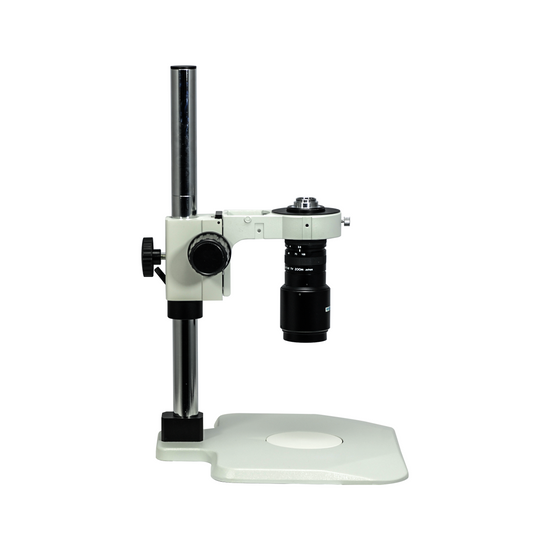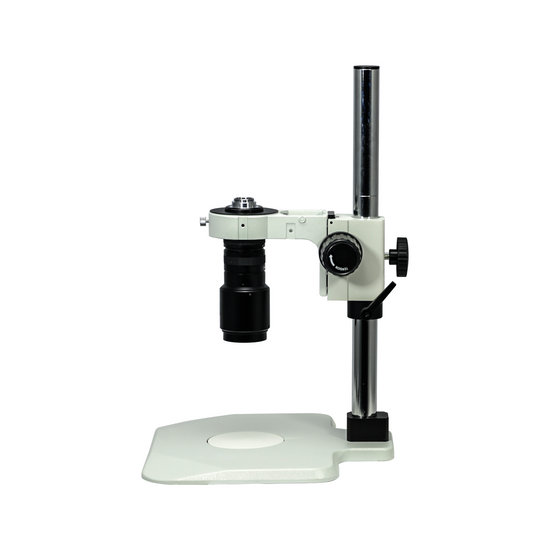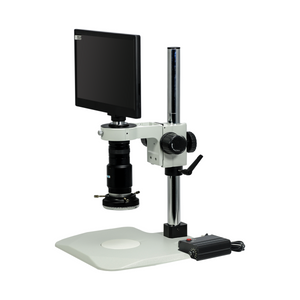Quick Overview
Infinite. Total Magnification: 1-6X. Zoom Ratio: 6:1. Body Mounting Size for Stand: Dia. 47mm. Post Stand. The optical system lens is provided by Navitar, and other accessories such as Stands, camera and light source are provided by our company.
MZ02110011 Video Zoom Microscope
Optical System Specifications
| Optical System | Infinite |
| System Optical Magnification | 1-6X |
| Total Magnification | 1-6X |
Video Monocular Zoom Body
| Navitar Zoom 7000 Macro Video Zoom Lens | |
| Body Optical System | Infinite |
| Body Magnification | 1-6X |
| Zoom Ratio | 6:1 |
| Zoom Operating Mode | With the Nosepiece |
| Body Mounting Size for Stand | Dia. 47mm |
| For Camera Sensor Size | Under 2/3 in. |
| Surface Treatment | Electroplating Black |
| Material | Metal |
| Color | Black |
| Net Weight | 0.58kg (1.28lbs) |
Post Stand
| 76mm Post Stand | |
| Stand Type | Post Stand |
| Holder Adapter Type | Dia. 76mm Scope Holder |
| Vertical Post Height | 305mm |
| Maximum Vertical Post Extended Length | 150mm |
| Vertical Post Diameter | Dia. 32mm |
| Base Type | Table Base |
| Base Shape | Rectangle |
| Base Mounting Size | M29x1.5-6h |
| Base Dimensions | 320x305x16mm |
| Focus Mode | Manual |
| Focus Distance | 50mm |
| Coarse Focus Distance per Rotation | 21mm |
| Focusing Knob Tightness Adjustable | Tightness Adjustable |
| Center Distance from Hole to Scope Holder | 150mm |
| Surface Treatment | Plastic Spray Coating |
| Material | Metal |
| Color | White |
| Net Weight | 3.25kg (7.17lbs) |
| Dimensions | 320x305x474mm (12.598x12.008x18.661 in. ) |
Donut Adapter
| 47/76mm Donut | |
| Donut Adapter Type | Scope Mounting Converter |
| Donut Adapter Size for Scope Mounting | Dia. 47mm |
| Donut Adapter Size for Scope Holder | Dia. 76mm |
| Donut Adapter Height | 20mm |
| Surface Treatment | Electroplating Black |
| Material | Metal |
| Color | Black |
| Net Weight | 0.18kg (0.40lbs) |
| Applied Field | For Navitar Zoom Series Lens |
Microscope Plate
| 95x5mm Black White Plate | |
| Plate Type | Black White Plate |
| Plate Size | Dia. 95x5mm |
| Material | Plastic (ABS) |
| Color | Black, White |
| Applied Field | For ST0201, ST0501, ST1901, ST0801, ST0802 Series Post Stand. ST0203, ST0204 ST0403 Series Track Stand |
Other Parameters
| Surface Treatment | Spray Paint |
| Material | Metal |
| Color | White |
| Net Weight | 4.00kg (8.82lbs) |
| Dimensions | 320x305x474mm (12.598x12.008x18.661 in. ) |
| Notes | The optical system lens is provided by Navitar, and other accessories such as Stands, camera and light source are provided by our company |
Technical Info
Instructions
Video Zoom LensClose Λ
| Video zoom lens, refers to microscope that has only one set of imaging optical paths. It can be considered as a set of dual optical path stereo microscopes. The magnification and multiple range of video zoom lens are usually the same as those of a stereo microscope, but because the objective lens is one, its optical imaging is flat, not stereoscopic. It has been observed that as most of the parametric features are close to stereo microscopes, video zoom lens is then classified as stereo microscope. In fact, it lacks the most important "stereoscopic" imaging features. Compared with other compound microscopes such as biological metallurgical microscopes, the total optical magnification of video zoom lens is generally below 40X, which is the coverage of low magnification range that these microscopes do not have. Most of the video continuous zoom lens is to observe the electronic image, not through the eyepiece, but through the camera. Video zoom lens can have relatively more objective lens and photographic eyepiece multiples for selection. At the same time, video zoom lens can also be designed as parallel light so as to add even more configuration accessories, such as observation eyepieces, aperture diaphragms, coaxial illumination light sources, reticles, and nosepieces that can change the viewing angle and direction, etc. Regarding accessories of video zoom lens such as the stands and light source etc., generally, all accessories of stereo microscope can be used. Therefore, video zoom lens combination is flexible, compact, with strong adaptability and low cost, suitable for use in industry, especially extensively used in the electronics industry. |
InfiniteClose Λ
| Microscopes and components have two types of optical path design structures. One type is finite optical structural design, in which light passing through the objective lens is directed at the intermediate image plane (located in the front focal plane of the eyepiece) and converges at that point. The finite structure is an integrated design, with a compact structure, and it is a kind of economical microscope. Another type is infinite optical structural design, in which the light between the tube lens after passing the objective lens becomes "parallel light". Within this distance, various kinds of optical components necessary such as beam splitters or optical filters call be added, and at the same time, this kind of design has better imaging results. As the design is modular, it is also called modular microscope. The modular structure facilitates the addition of different imaging and lighting accessories in the middle of the system as required. The main components of infinite and finite, especially objective lens, are usually not interchangeable for use, and even if they can be imaged, the image quality will also have some defects. The separative two-objective lens structure of the dual-light path of stereo microscope (SZ/FS microscope) is also known as Greenough. Parallel optical microscope uses a parallel structure (PZ microscope), which is different from the separative two-object lens structure, and because its objective lens is one and the same, it is therefore also known as the CMO common main objective. |
System Optical MagnificationClose Λ
| The magnification of the objective lens refers to the lateral magnification, it is the ratio of the image to the real size after the original image is magnified by the instrument. This multiple refers to the length or width of the magnified object. System optical magnification is the product of the eyepiece and the objective lens (objective lens zoom set) of the optical imaging part within the system. Optical magnification = eyepiece multiple X objective lens/objective lens set The maximum optical magnification of the microscope depends on the wavelength of the light to which the object is illuminated. The size of the object that can be observed must be greater than the wavelength of the light. Otherwise, the light cannot be reflected or transmitted, or recognized by the human eye. The shortest wavelength of ultraviolet light is 0.2 microns, so the resolution of the optical microscope in the visible range does not exceed 0.2 microns, or 200 nanometers. This size is converted to the magnification of the microscope, and it is the optical magnification of 2000X. Usually, the compound microscope can achieve 100X objective lens, the eyepiece is 20X, and the magnification can reach 2000X. If it is bigger, it will be called "invalid magnification", that is, the image is large, but the resolution is no longer increased, and no more details and information can be seen. |
Total MagnificationClose Λ
| Total magnification is the magnification of the observed object finally obtained by the instrument. This magnification is often the product of the optical magnification and the electronic magnification. When it is only optically magnified, the total magnification will be the optical magnification. Total magnification = optical magnification X electronic magnification Total magnification = (objective X photo eyepiece) X (display size / camera sensor target ) |
Video Monocular Zoom BodyClose Λ
| Video monocular zoom body is a zoom body that has only one set of optical paths, and it is also the body of the video continuous zoom. The upper end of the microscope body can be connected to the standard C-interface photo eyepiece, and then connected to the microscope camera; the lower end is the objective lens, and the objective lens of parallel structure is generally separated from the body, whereas the microscope body of finite structure is combined with the objective lens. Some bodies of microscope have also a light source coaxial illumination device. |
Zoom RatioClose Λ
| Zoom ratio is the ratio of the maximum magnification / the minimum magnification. Expressed as 1: (ratio of maximum magnification / minimum magnification). If the maximum magnification is 4.5X, the minimum magnification is 0.7X, then the zoom ratio = 4.5 / 0.7 = 6.4, the zoom ratio will be 1:6.4. Zoom ratio is obtained by the intermediate magnification group of the microscope. When the magnification is increased or decreased by using other objective lenses, the zoom ratio does not change accordingly. |
With the NosepieceClose Λ
| When the microscope body changes the magnification, it is realized by adjusting the zoom drum or nosepiece. Generally, the lower case of the microscope is used as the zoom drum or nosepiece. When magnification conversion is required, it can be realized by turning the zoom drum or nosepiece. |
For Camera Sensor SizeClose Λ
| For the size of the lens field of view of the coupler/C-mount-adapter, in the design process, the size of the camera sensor imaging target should be considered. When the field of view of the lens is smaller than the target plane of the camera, “black border” and “dark corner” will appear. The general microscope coupler/C-mount adapters are generally designed for the 1/2" camera targets. When a camera of 2/3 or larger target is used, the “dark corner” phenomenon will appear in the field of view. Especially, at present, DSLR cameras generally use large target plane design (1 inch full field of view), when used for microscopic photographing, the general DSLR camera coupler/C-mount adapter will have “black border”. Generally, the “dark corner” that appears on the field of view is often that the center of the microscope and the camera are not aligned. Adjust the position of the screw on the camera adapter, or turn the camera adapter to adjust or change the effect. |
Post StandClose Λ
| Post stand generally has relatively tall post. When the focus is adjusted, the focusing mechanism can slide up and down the post, the microscope is thus placed in an approximately focused position, and then the focusing mechanism makes fine and accurate adjustment. This kind of stand can move quickly, and is suitable for viewing objects with a higher height and bigger volume. After the microscope is mounted, the microscope imaging center needs to be aligned with the center of the platen. The focusing mechanism button on the post must be tightened to lock the guard ring device, and the microscope should be prevented from loosening and shaking when working. When it is necessary to adjust the height, hold the microscope and the focusing mechanism with one hand, then release the knob, adjust it to the proper position, lock the knob, then top the guard ring to the lower position of the focusing mechanism, and lock it tight. In particular, avoid accidental dropping of the microscope due to gravity, thereby damaging the microscope and the objects below. |
Dia. 76mm Scope HolderClose Λ
| The 76mm stand scope holder is the most popular microscope body adapter size, suitable for stereo microscopes produced by most manufacturers. Place the microscope body in a 76mm scope holder, tighten with screws to avoid shaking when the microscope is in use. Because this stand scope holder is very common, some special-sized microscopes can also borrow and use this stand, but only need a specific adapter to connect the microscope body with a diameter of less than 76mm. |
Focusing Knob Tightness AdjustableClose Λ
| Different microscope bodies, different human operations, and different requirements for observation and operation, all require adjustment of the pre-tightening force of the stand that support microscope body. Facing the stand just right, use both hands to reverse the force to adjust the tightness. (face the knob of one side just right, clockwise is to tighten, counterclockwise is to loosen) In general, after long-time use, the knob will be loose, and adjustment is necessary. |
Donut AdapterClose Λ
| Donut adapter is an adapter used to convert the scope holder of the microscope and the size of the microscope body. For different manufacturers and different types of microscopes, as well as different stands, their adapters are often different and not interchangeable. This type of donut adapter can be used to connect different microscope stands and microscope bodies, which is very convenient for interchange of different manufacturers and microscope models. It is usually to use this adapter cable to fix it to the body of the microscope, which is equivalent to changing the fixed diameter of the microscope, and then placing it on the microscope stand. |
Microscope PlateClose Λ
| According to different objects to be observed, the appropriate platen should be selected. The microscope plate materials include black and white, black and white finish; transparent glass, frosted glass, metal, etc. Standard stands are generally configured with a suitable microscope plate, but different plates may need to be purchased separately. Black and white microscope plate are made of general plastics, and the different backgrounds in black and white make the object more prominent. Finish microscope plate eliminates reflections during observation. Transparent glass plate is used when observing transparent or translucent objects, and the use of transmitted light source is to make the light penetrate the object to be observed as much as possible. Finish glass plate, with its rough glass surface, can make the transmitted light more uniform and create a diffusing effect, avoiding exposure of the light shadow of the filament directly onto to the observed object. Metal plate, relatively more solid, is more suitable when it is necessary to operate and cut. Microscope plate is generally round shaped, on one side of the base there is a spring clip. When installing, align the plate with the clamp and push it in, and then press down the other end, so that the plate is smoothly embedded in to the circular card slot of the bottom plate. When removing, grab the other end of the clip, push and lift up the plate. |
PackagingClose Λ
| After unpacking, carefully inspect the various random accessories and parts in the package to avoid omissions. In order to save space and ensure safety of components, some components will be placed outside the inner packaging box, so be careful of their inspection. For special packaging, it is generally after opening the box, all packaging boxes, protective foam, plastic bags should be kept for a period of time. If there is a problem during the return period, you can return or exchange the original. After the return period (usually 10-30 days, according to the manufacturer’s Instruction of Terms of Service), these packaging boxes may be disposed of if there is no problem. |
| Contains | |||||||||||||
| Parts Including | |||||||||||||
| |||||||||||||
| Packing | |
| Packaging Type | Carton Packaging |
| Packaging Material | Corrugated Carton |
| Packaging Dimensions(1) | 38x36x19cm (14.961x14.173x7.480″) |
| Packaging Dimensions(2) | 21x8.5x9cm (8.268x3.346x3.543″) |
| Packaging Dimensions(3) | 10.5x5.5x13cm (4.133x2.165x5.118″) |
| Inner Packing Material | Plastic Bag |
| Ancillary Packaging Materials | Expanded Polystyrene |
| Gross Weight | 5.05kg (11.13lbs) |
| Minimum Packaging Quantity | 1pc |
| Transportation Carton | Carton Packaging |
| Transportation Carton Material | Corrugated Carton |
| Transportation Carton Dimensions(1) | 38x36x19cm (14.961x14.173x7.480″) |
| Transportation Carton Dimensions(2) | 21x8.5x9cm (9x4x4″) |
| Transportation Carton Dimensions(3) | 15.2x15.2x15.2cm (6x6x6″) |
| Total Gross Weight of Transportation(kilogram) | 5.05 |
| Total Gross Weight of Transportation(pound) | 11.13 |
| Quantity of One Transportation Carton | 3pc |


















